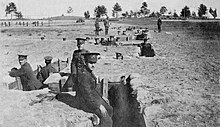Canadian Forces Base Borden (CFB Borden) is located approximately 100 kilometers north of Toronto in the heart of Simcoe County, one of the major tourist areas in Ontario. Borden is a small town adjacent to the town of Angus, a growing community with several subdivisions and new homes being built. It’s a short 25 minute drive into Barrie, Simcoe County’s largest city, with a population of 145,000. Borden provides jobs for civilian employees and independent contractors.
CFB Borden trains 15,000 military personnel annually, employs approximately 3,250 military members and approximately 1,500 civilians. CFB Borden units are comprised of 21,000 acres of land, including a 6,000-acre training area and approximately 460 buildings. Many military personnel are sent to Borden for specialized training which could be anywhere from 2 weeks to 2 year long courses.
Canadian Forces Support Training Group (CFSTG) is responsible for six training establishments, including four that call CFB Borden home. CFSTG trains approximately 16,000 military personnel annually and employs approximately 3,200 military members and 1,200 civilian employees. Every year new training facilities are being built for changing defence requirements. Local fire departments utilize the fire academy, police departments utilize the ranges and in the summer Blackdown Park is home to hundreds of military cadets.
At the height of the First World War, the Borden Military Camp opened at a location on a glacial moraine west of Barrie in 1916 to train units for the Canadian Expeditionary Force. It was named for Sir Frederick William Borden, former Minister of Militia. In May 1916, the Barrie and Collingwood companies of the 157th Battalion (Simcoe Foresters), CEF (perpetuated today by The Grey and Simcoe Foresters ), under the command of Lieutenant-Colonel D. H. MacLaren, began construction of the camp. Camp Borden was selected in 1917 for a military aerodrome, becoming the first flying station of the Royal Flying Corps Canada. During the inter-war period, the aerodrome was used as the training location for the nascent Royal Canadian Air Force (RCAF) and was renamed RCAF Station Borden. Camp Borden’s training grounds were expanded in 1938 to house the Canadian Tank School. The Siskins were a RCAF aerobatic flying team that was established in 1929 at Camp Borden.
During the Second World War, both Camp Borden and RCAF Station Borden became the most important training facility in Canada, housing both army training and flight training, the latter under the British Commonwealth Air Training Plan (BCATP). The BCATP’s No. 1 Service Flying Training School (SFTS) was located here until 1946. Relief landing fields were located at Alliston and Edenvale.
A third landing field, known locally as Leach’s Field, was operated by Camp Borden from the 1920s to the 1950s. The L-shaped airstrip was rudimentary; the “runways” at Leach’s Field utilized the existing ground surface. It was primarily used for touch-and-go flying.

Royal Canadian Air Force fire house, Camp Borden, Ontario

Soldiers training for trench warfare at Camp Borden in 1916
During the Cold War, Borden’s importance as an RCAF facility in Ontario declined in favour of CFB Trenton, CFB Uplands and CFB North Bay. However, its use as an army facility stayed consistent until 1970 when a major reorganization of the combat arms’ schools resulted in the transfer of the Infantry School and Armoured School to CFB Gagetown in New Brunswick. On the other hand, numerous “purple” (i.e. tri-service) schools were established or expanded from existing service training establishments, including the Canadian Forces School of Administration and Logistics, the School of Aerospace Ordnance Engineering and the Canadian Forces Health Service Training Centre.
The February 1, 1968 unification of the RCAF with the Royal Canadian Navy and the Canadian Army resulted in the creation of the Canadian Forces. The military facilities consisting of Camp Borden and RCAF Station Borden were grouped under a new name, Canadian Forces Base Borden (CFB Borden). The aerodrome was closed in 1970 and the base saw use as a regular and reserve training facility for Canadian Forces Land Force Command(the army), as well as hosting various land-based training courses for Canadian Forces Air Command (the air force). In a 1990s reorganization of the Canadian Forces following the end of the Cold War, CFB Borden’s air force training facilities were grouped under the name 16 Wing Borden.
The eight surviving Royal Flying Corps hangars at the base have been designated a National Historic Site of Canada.
